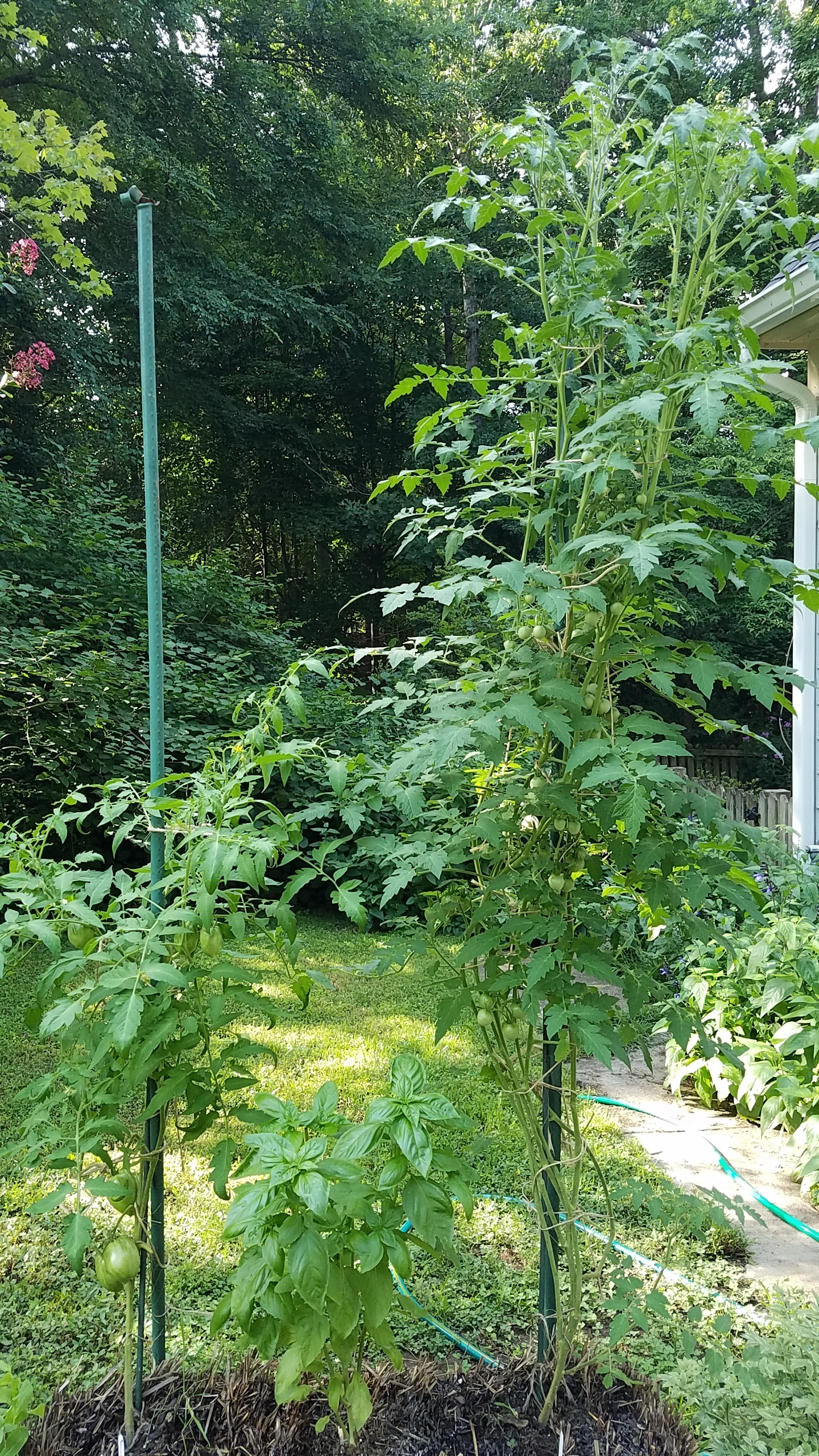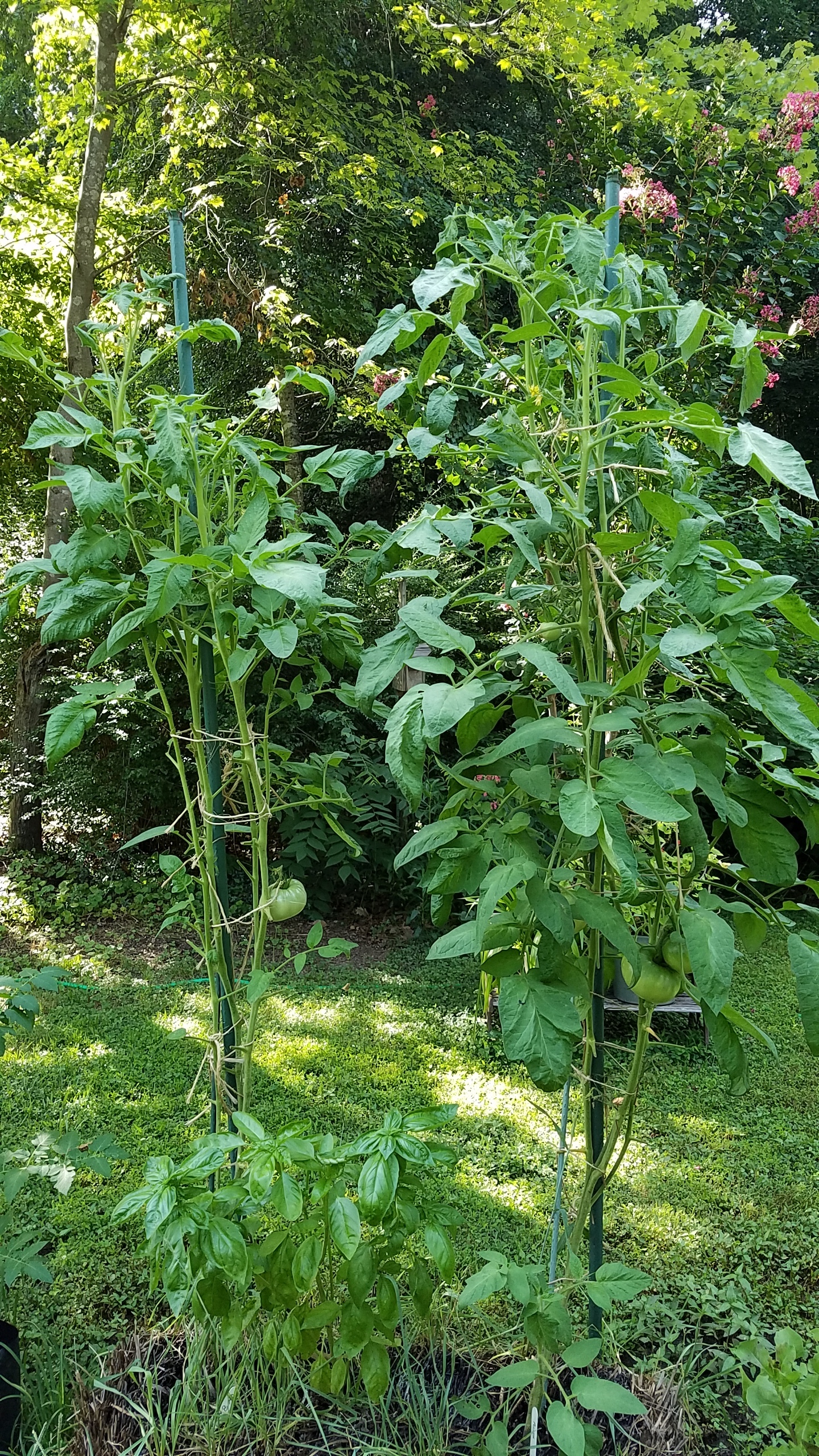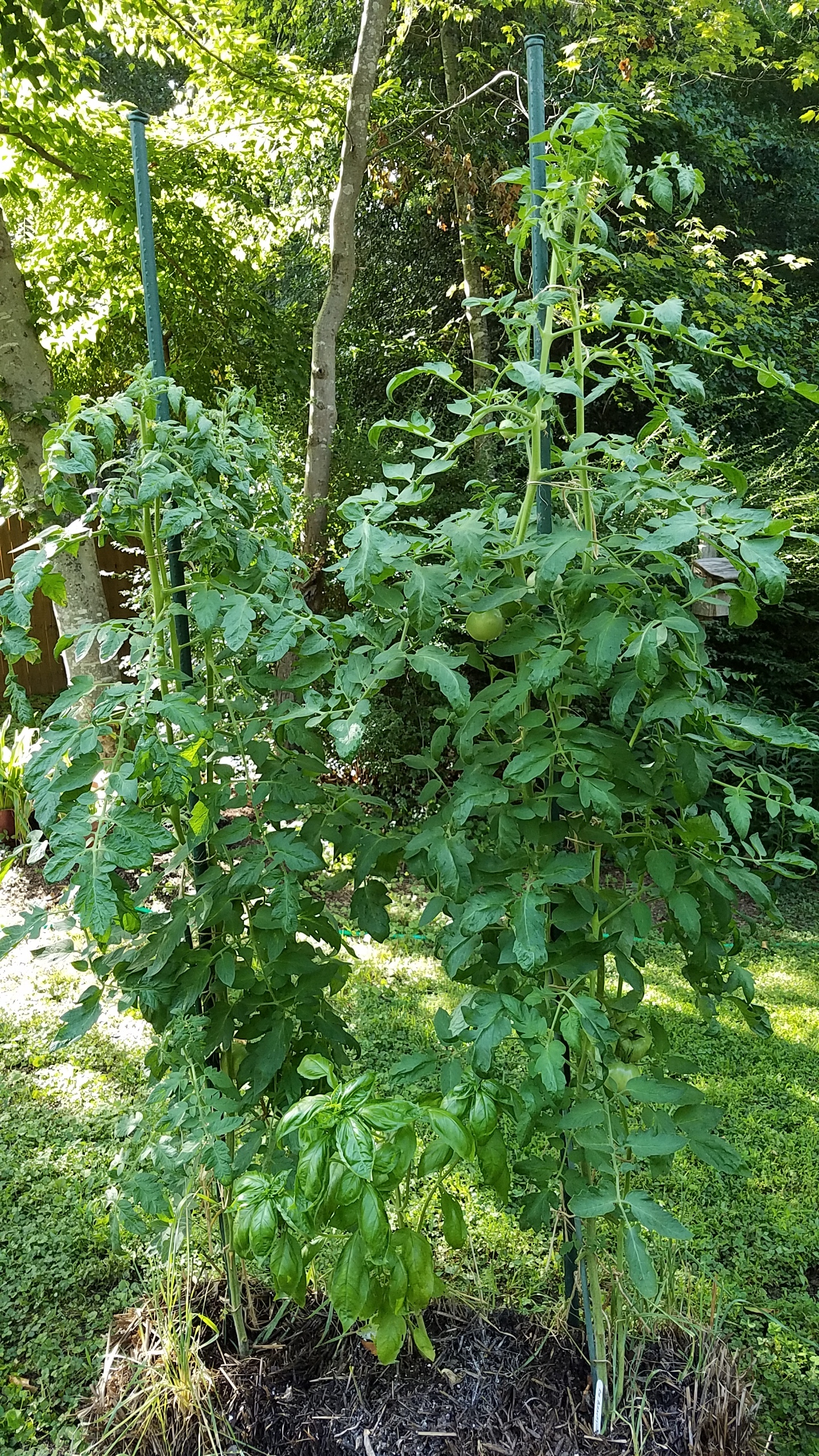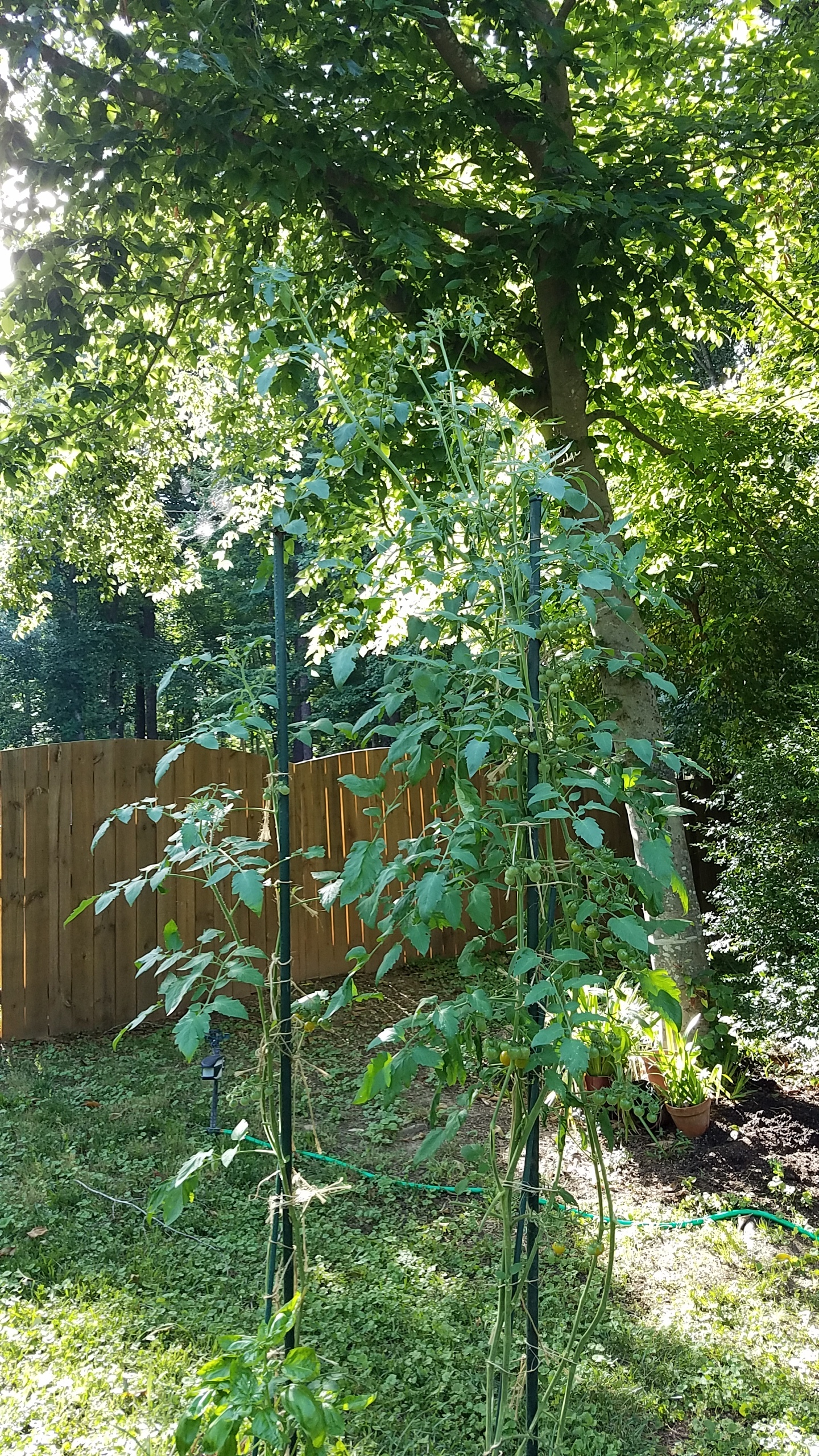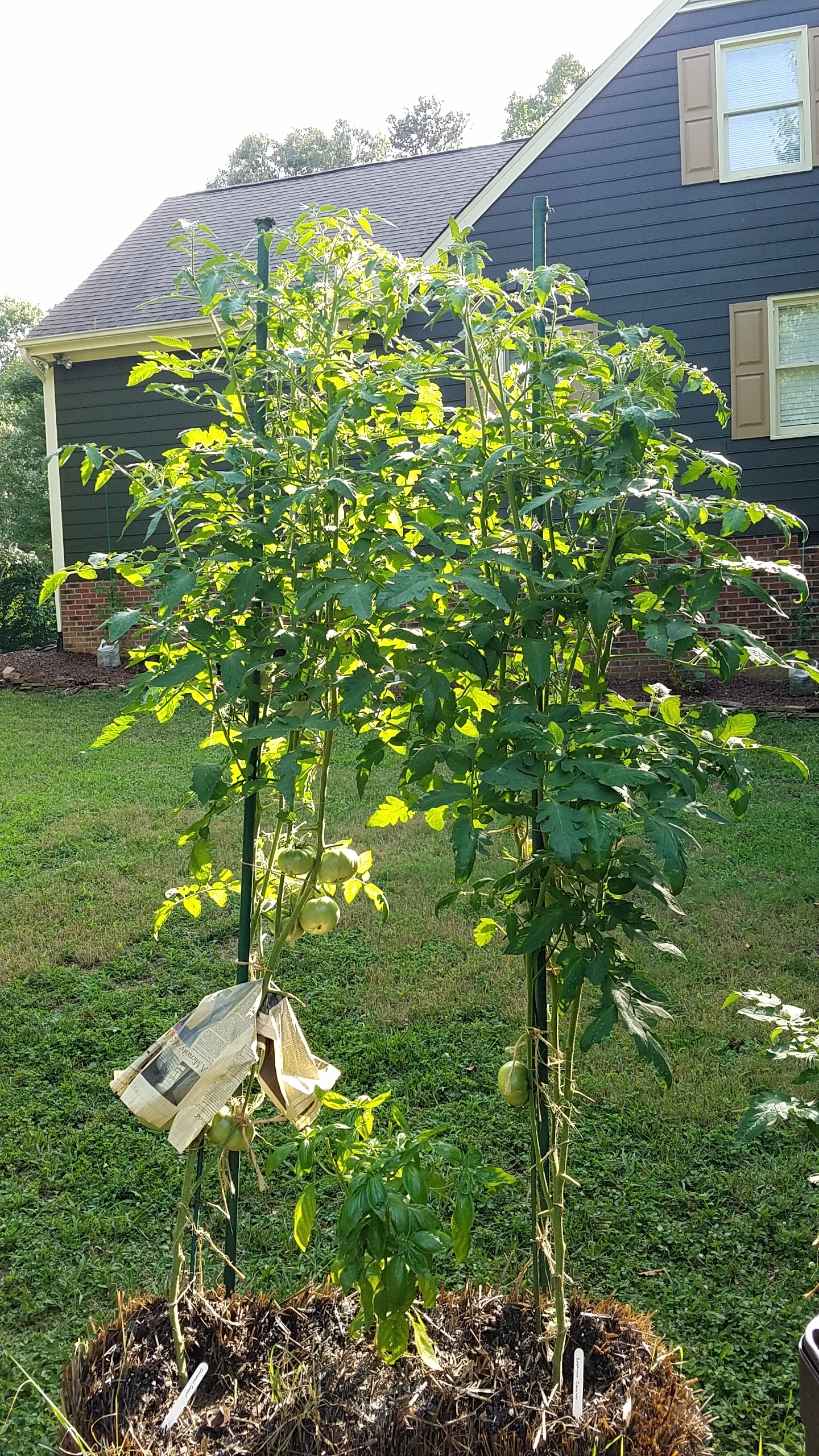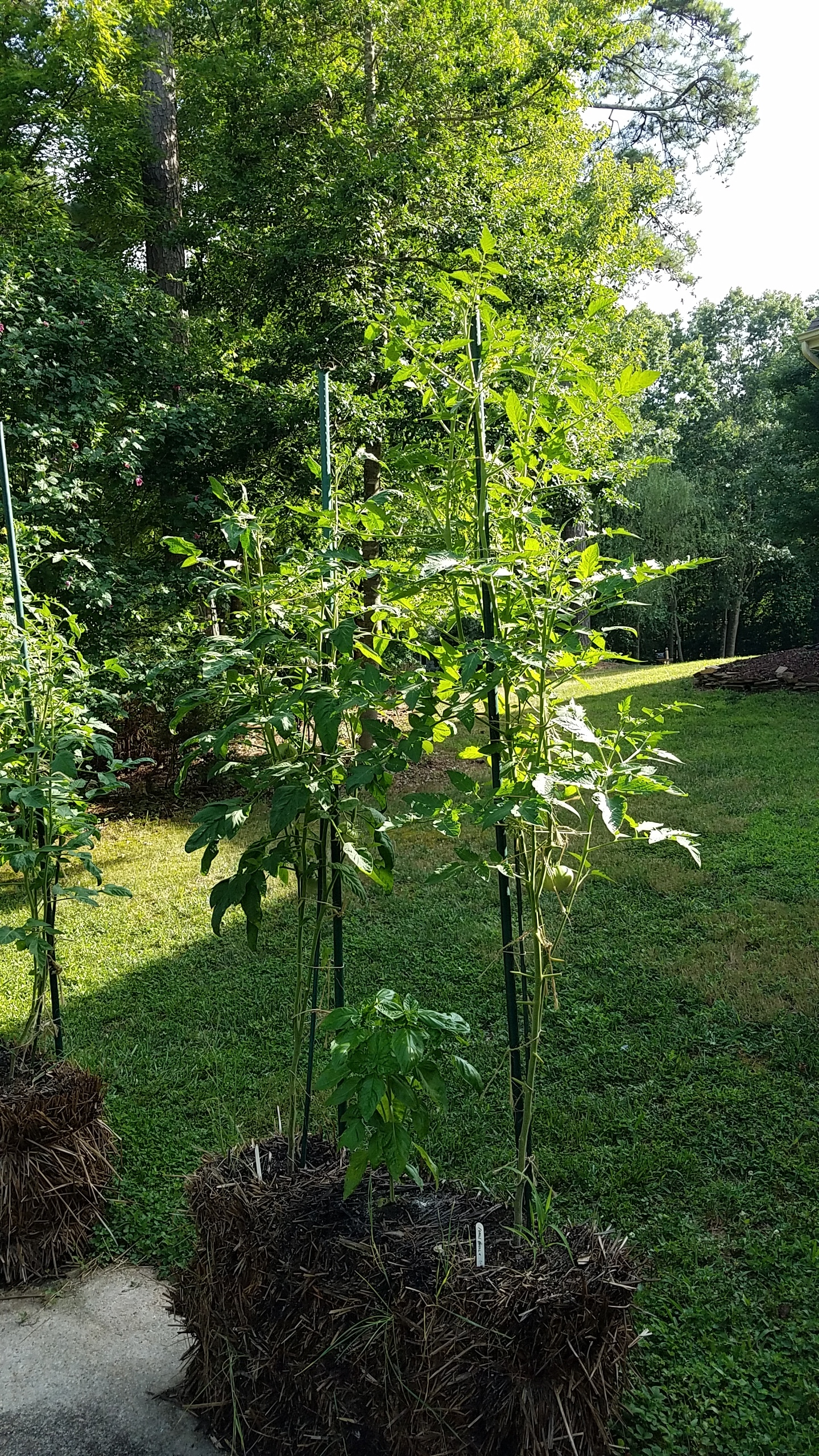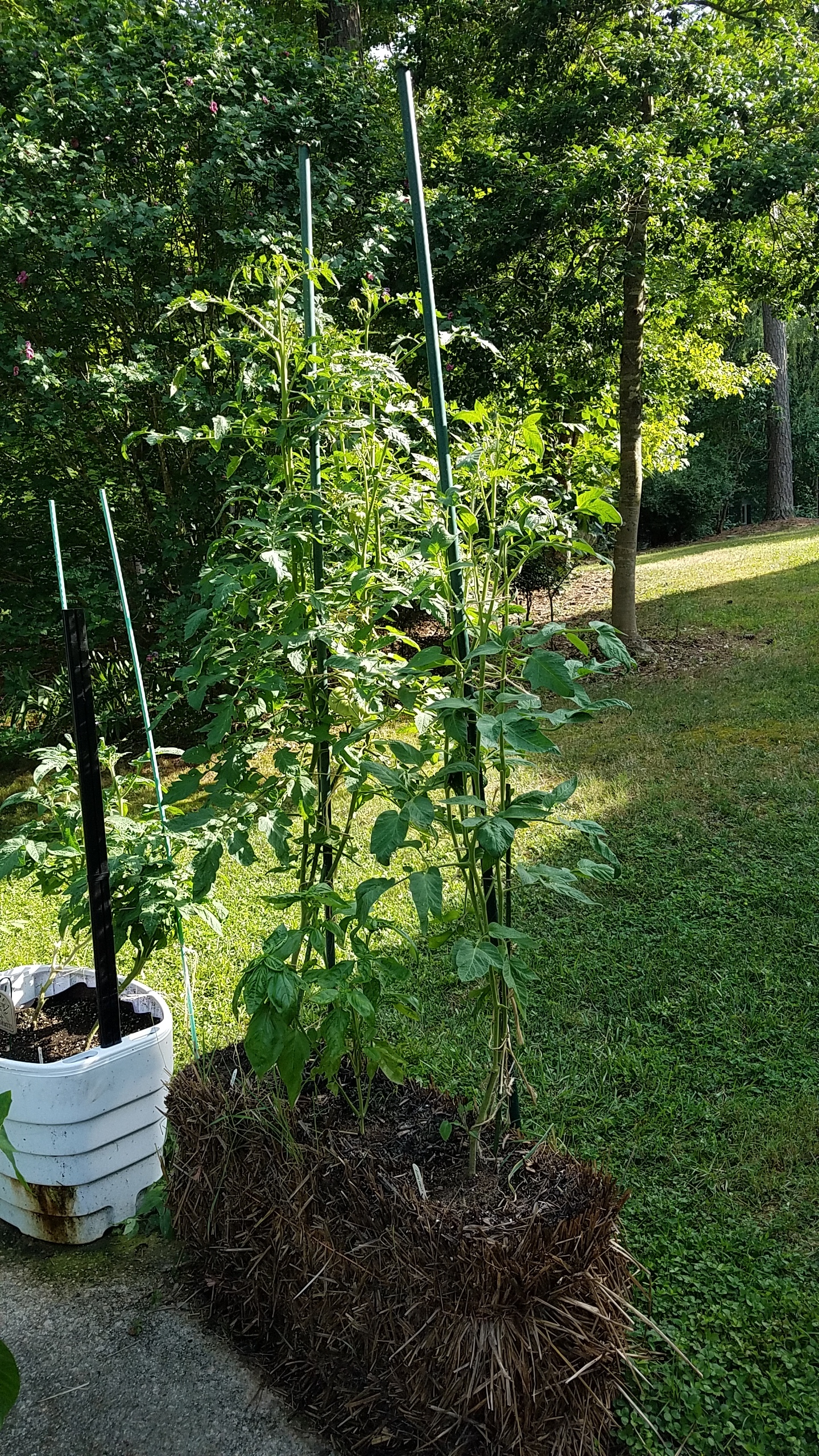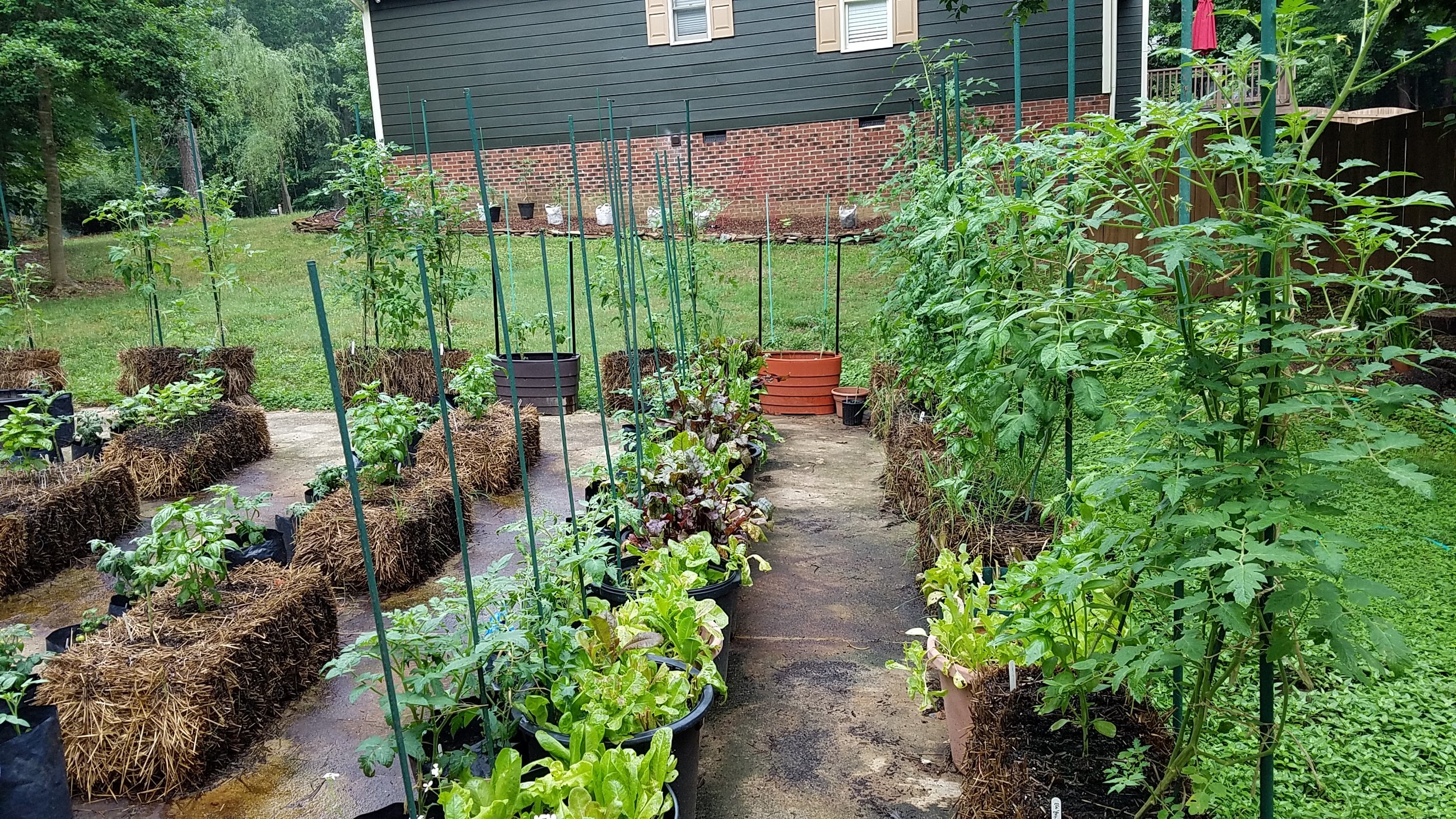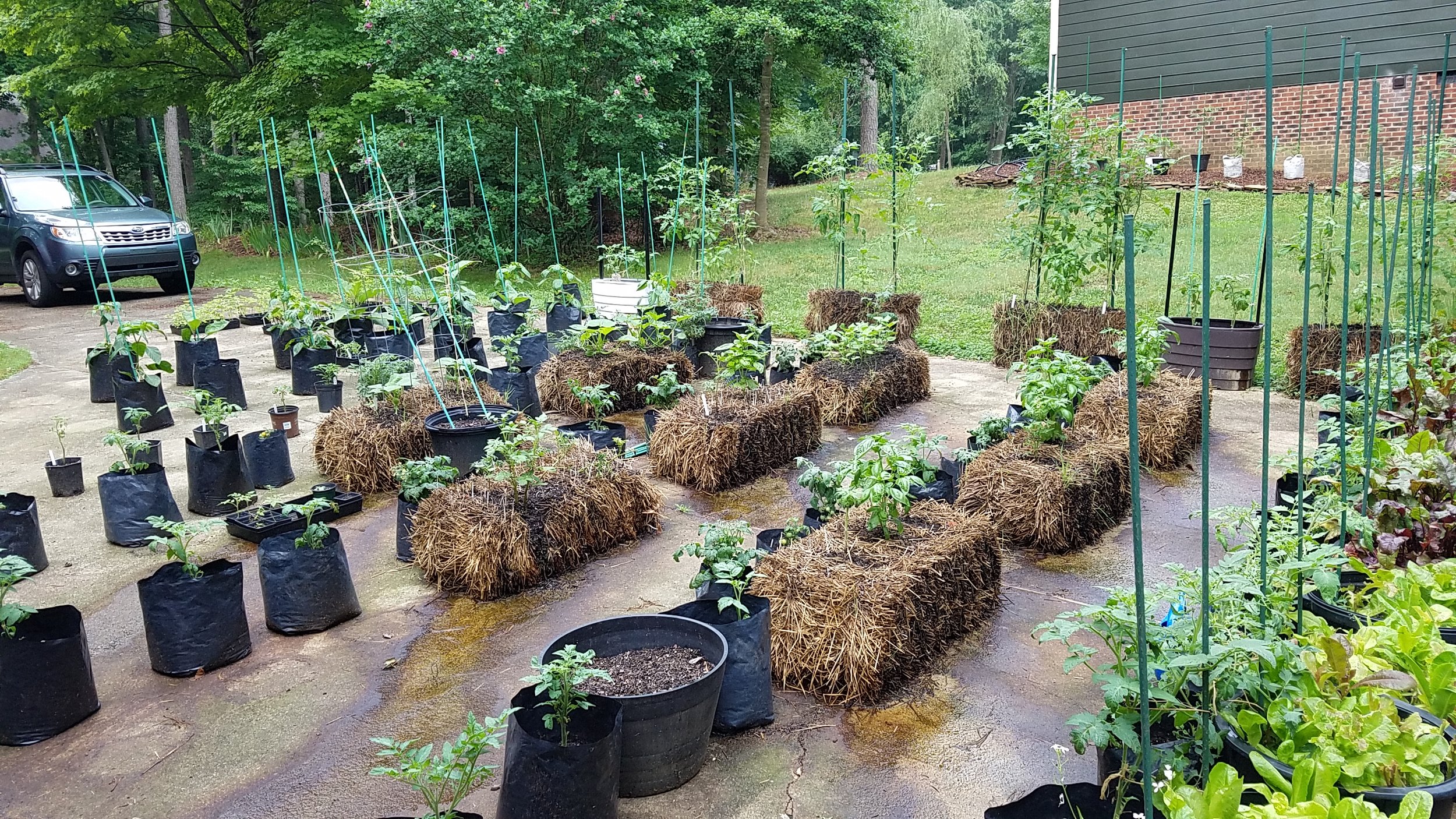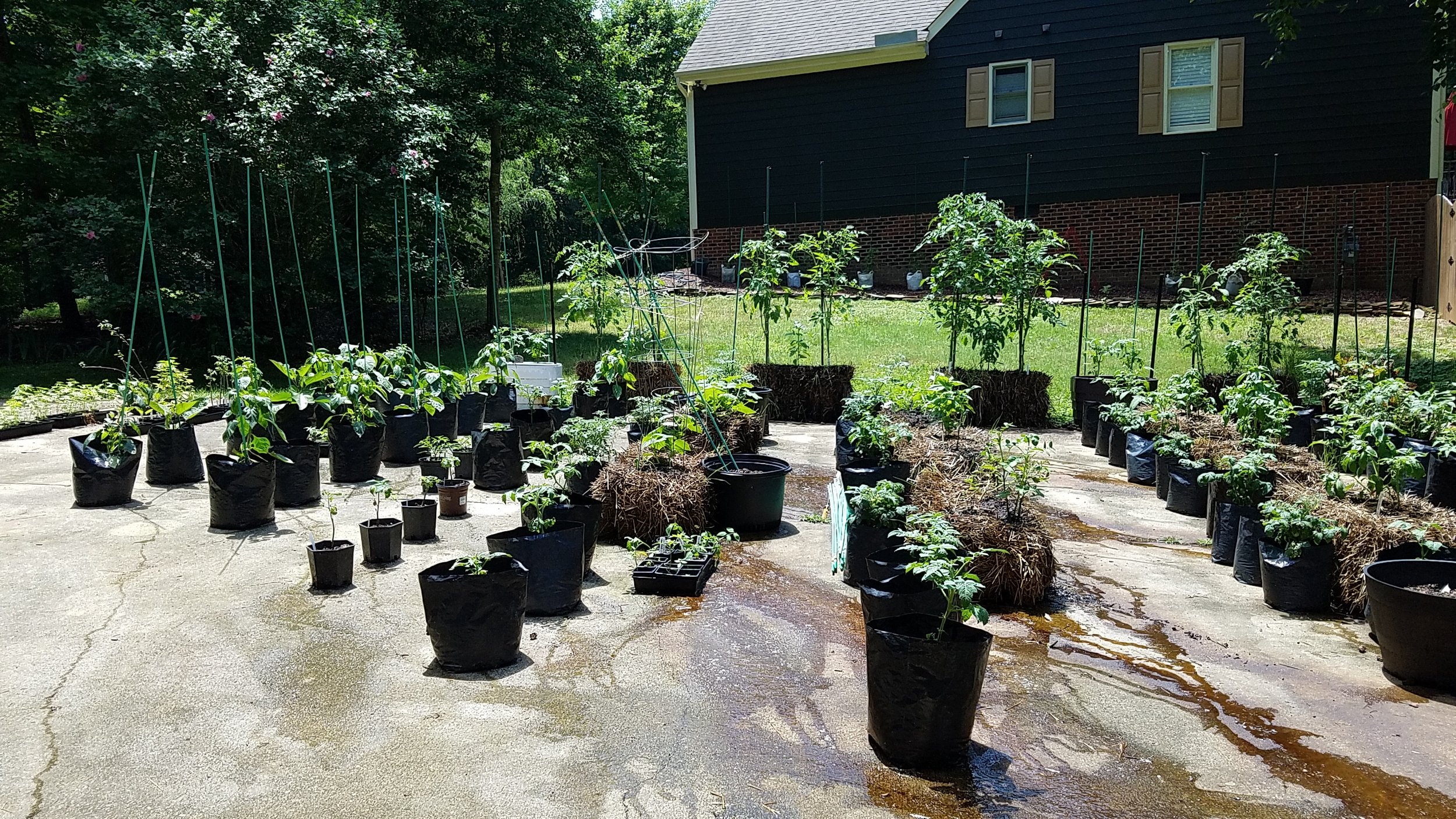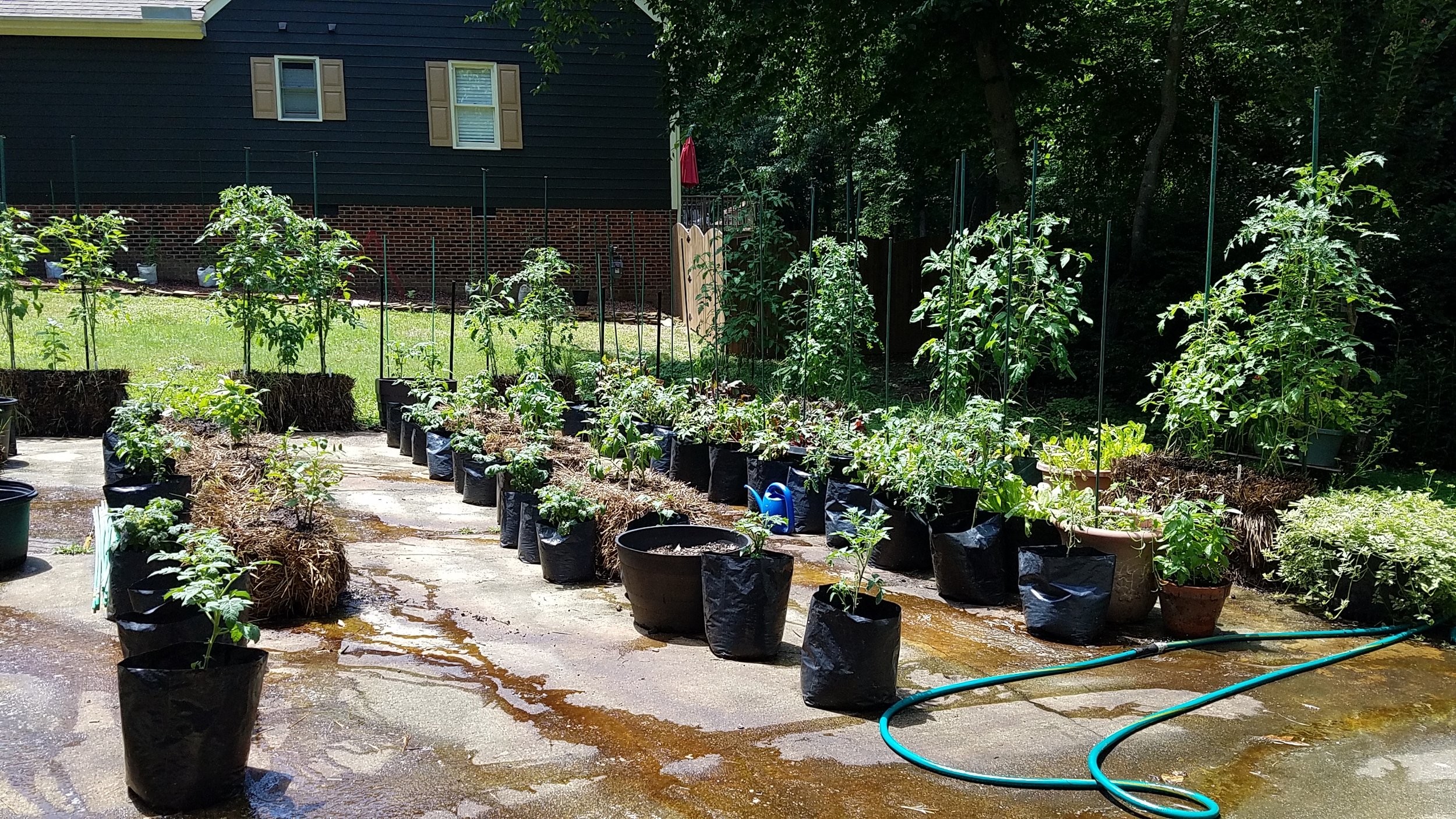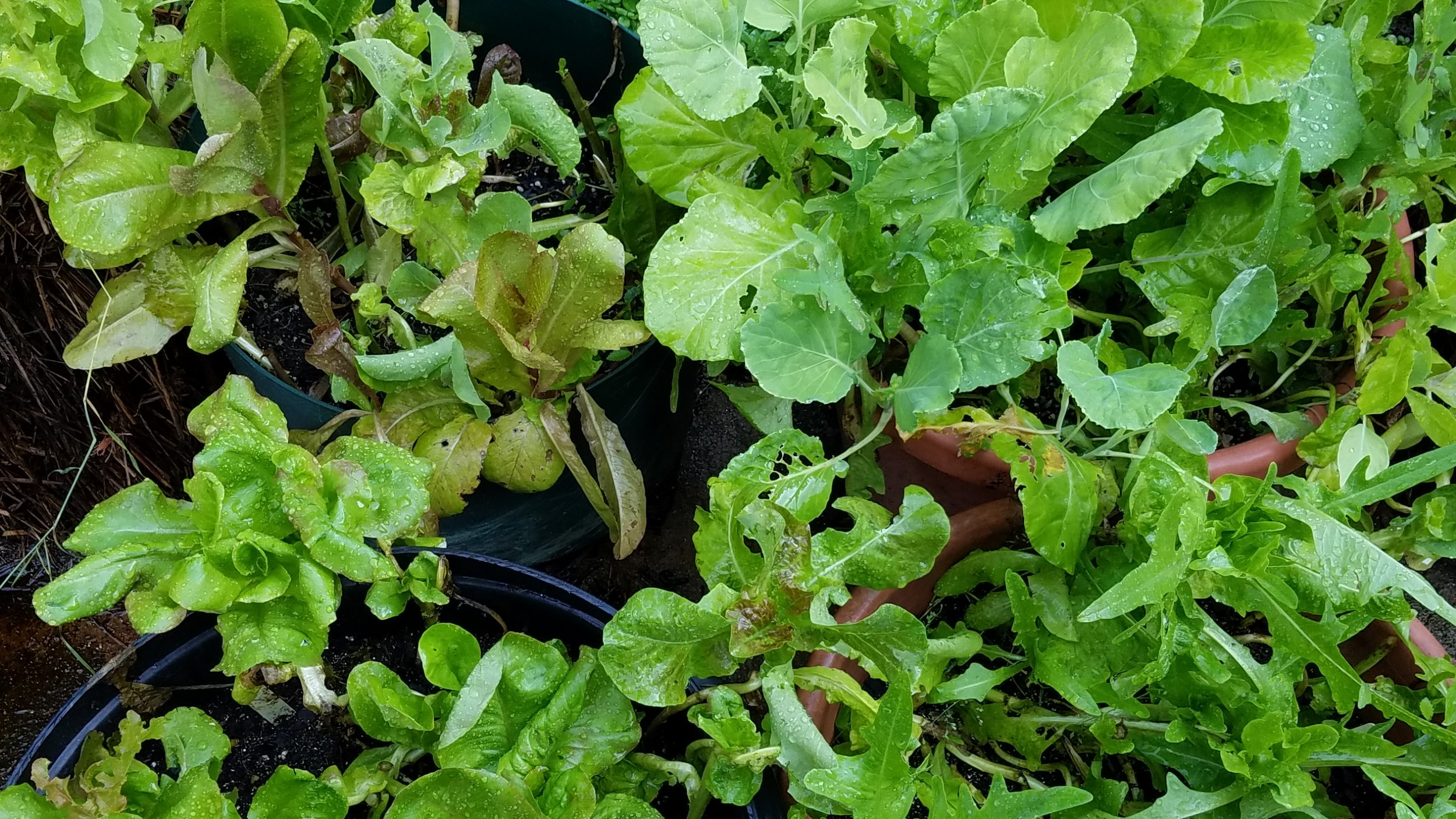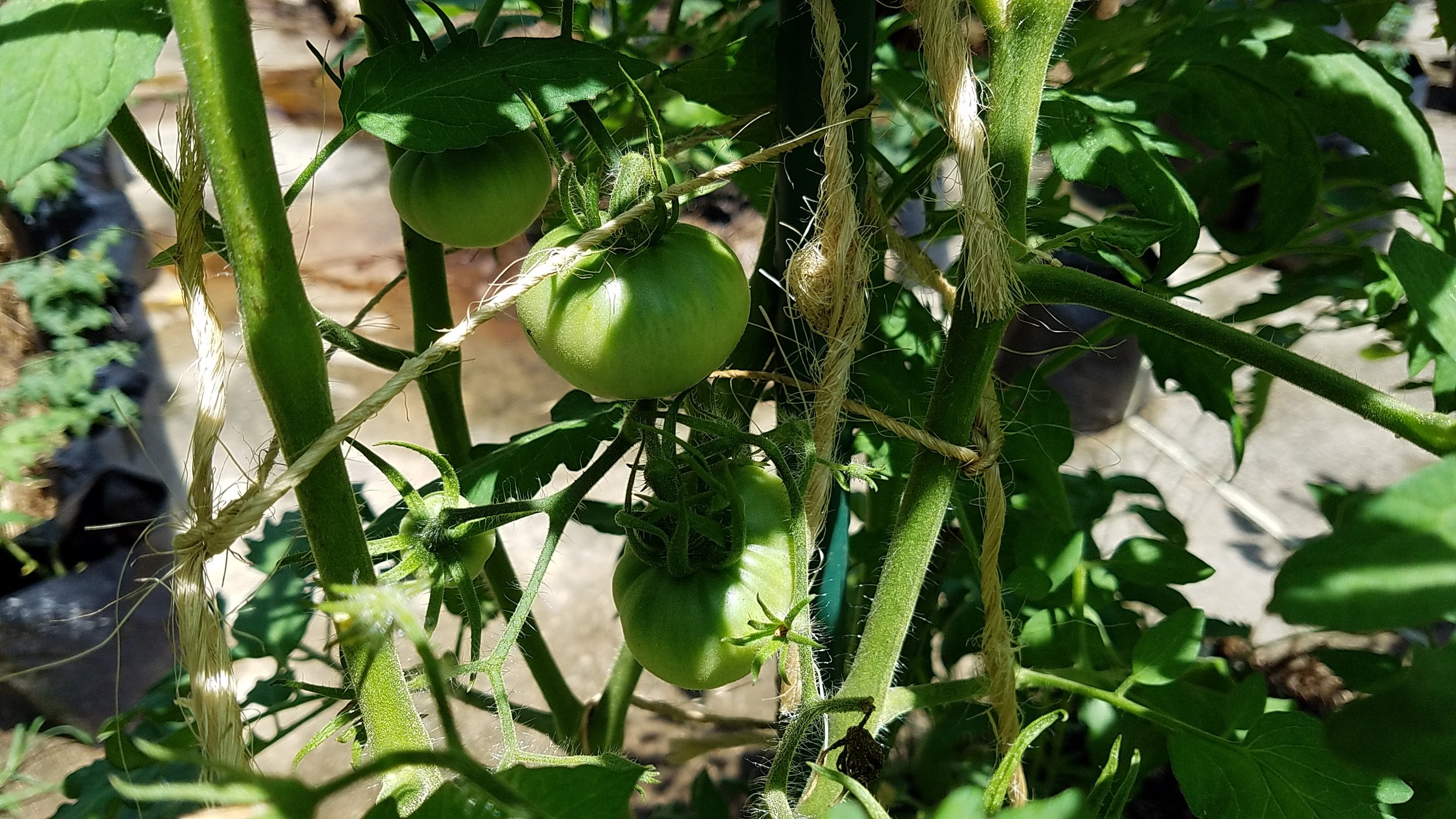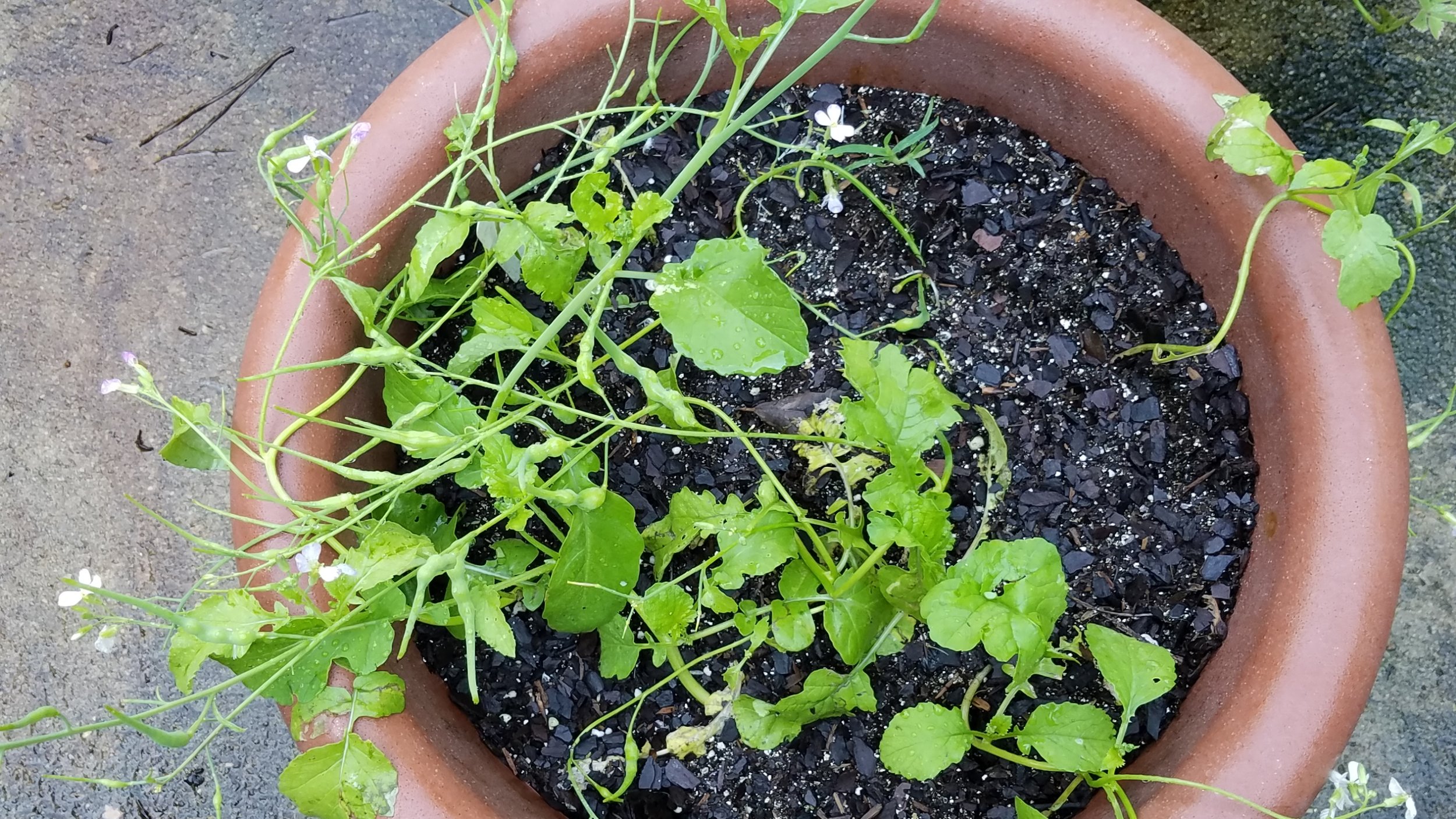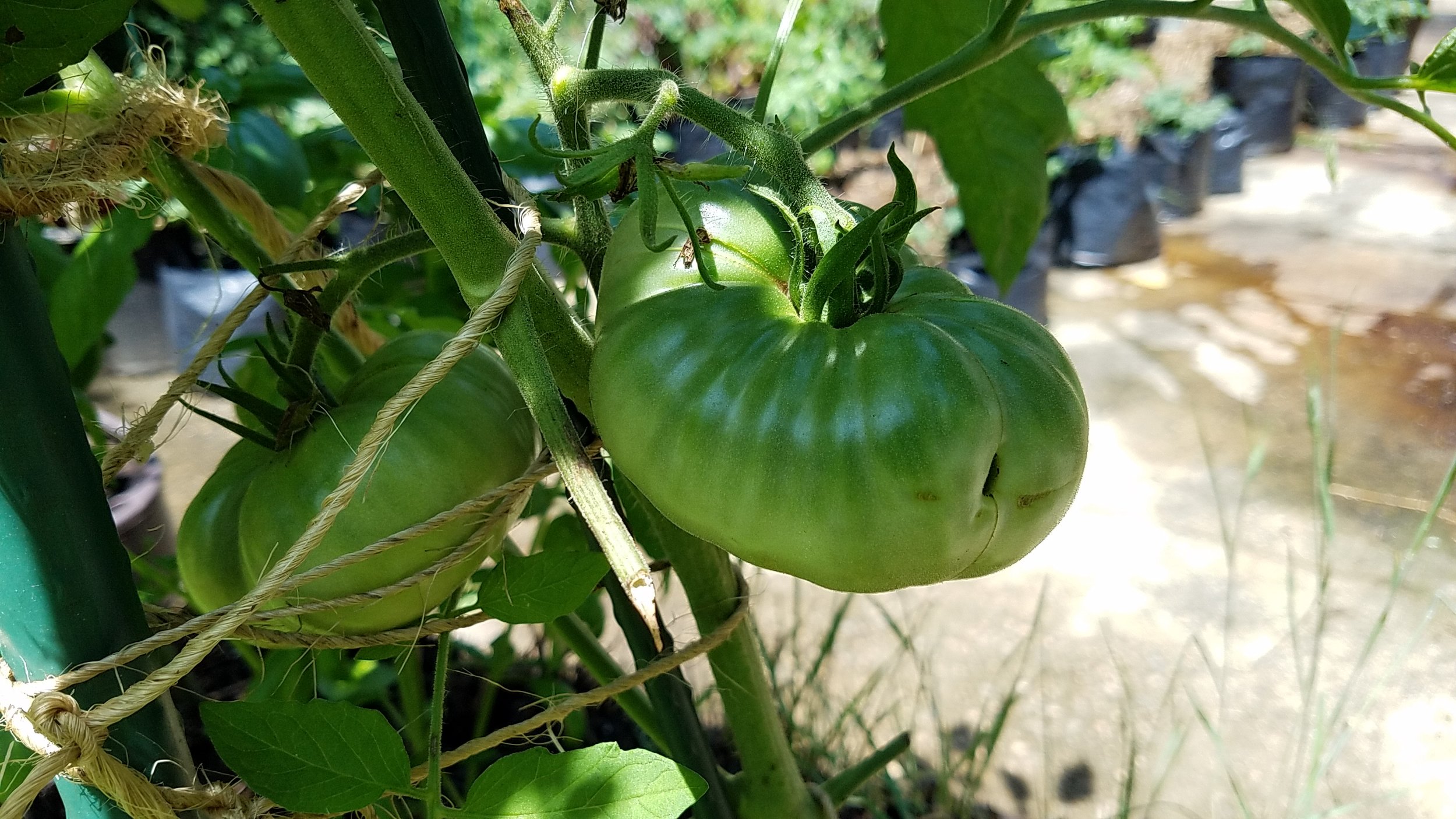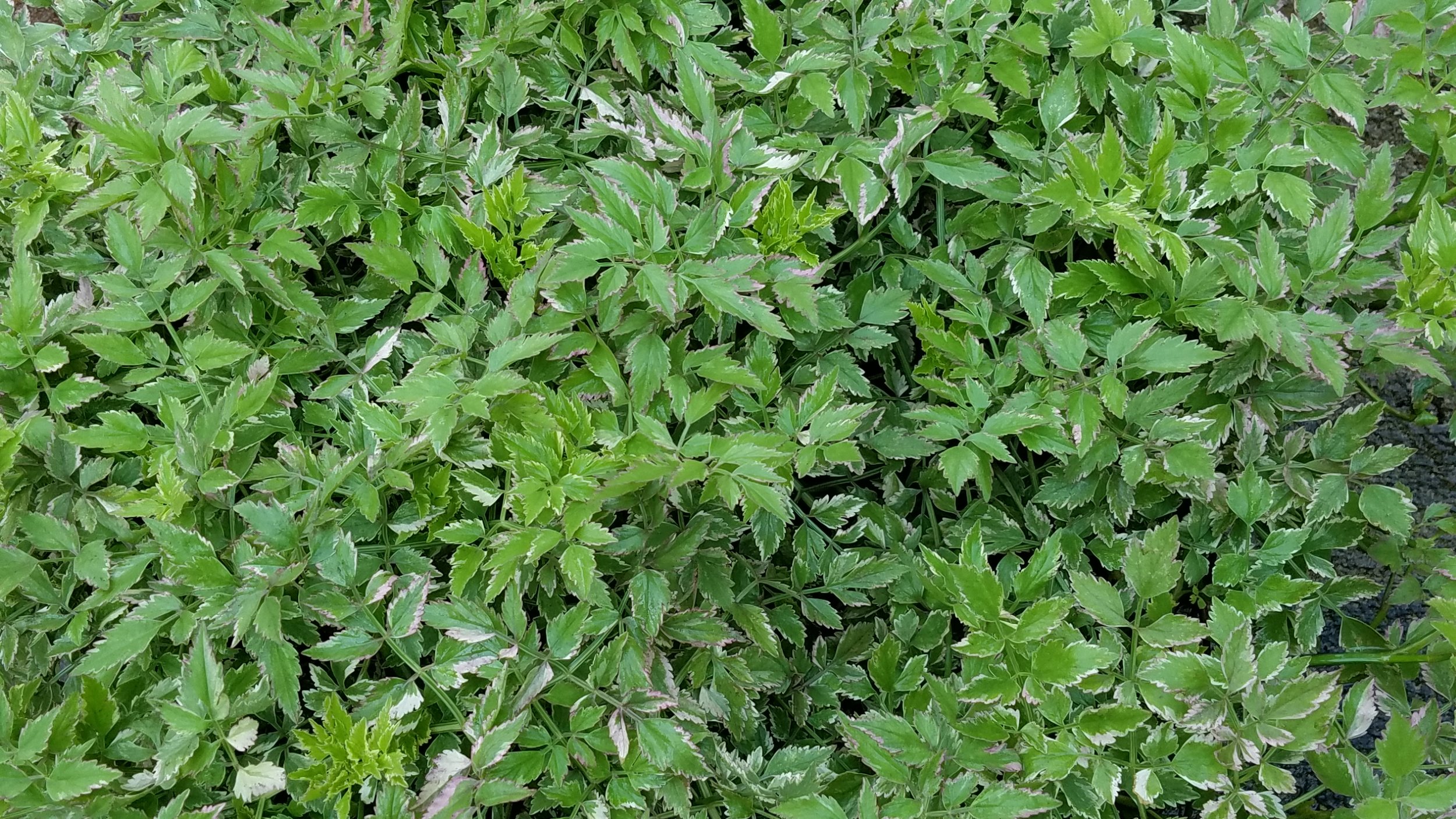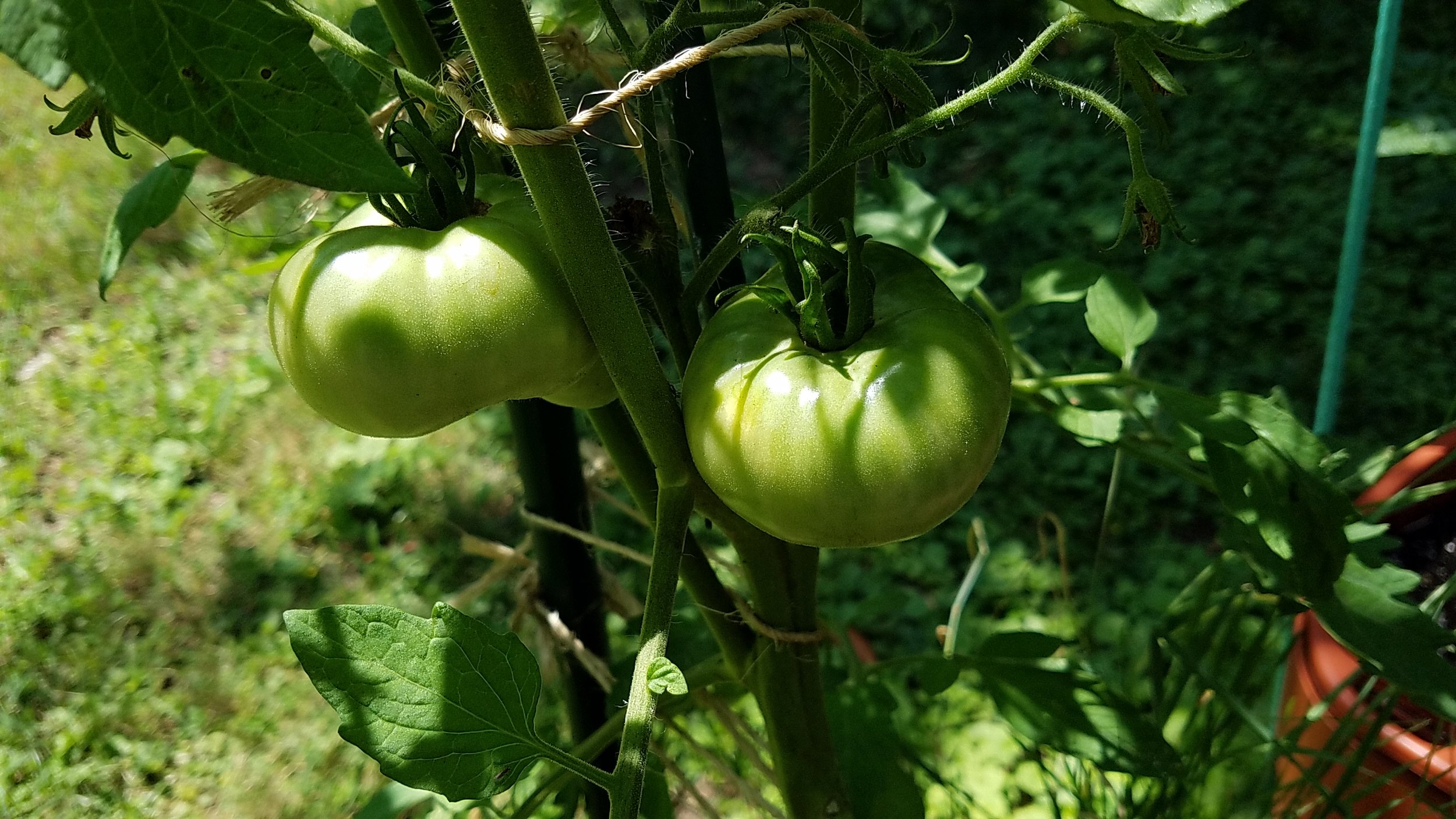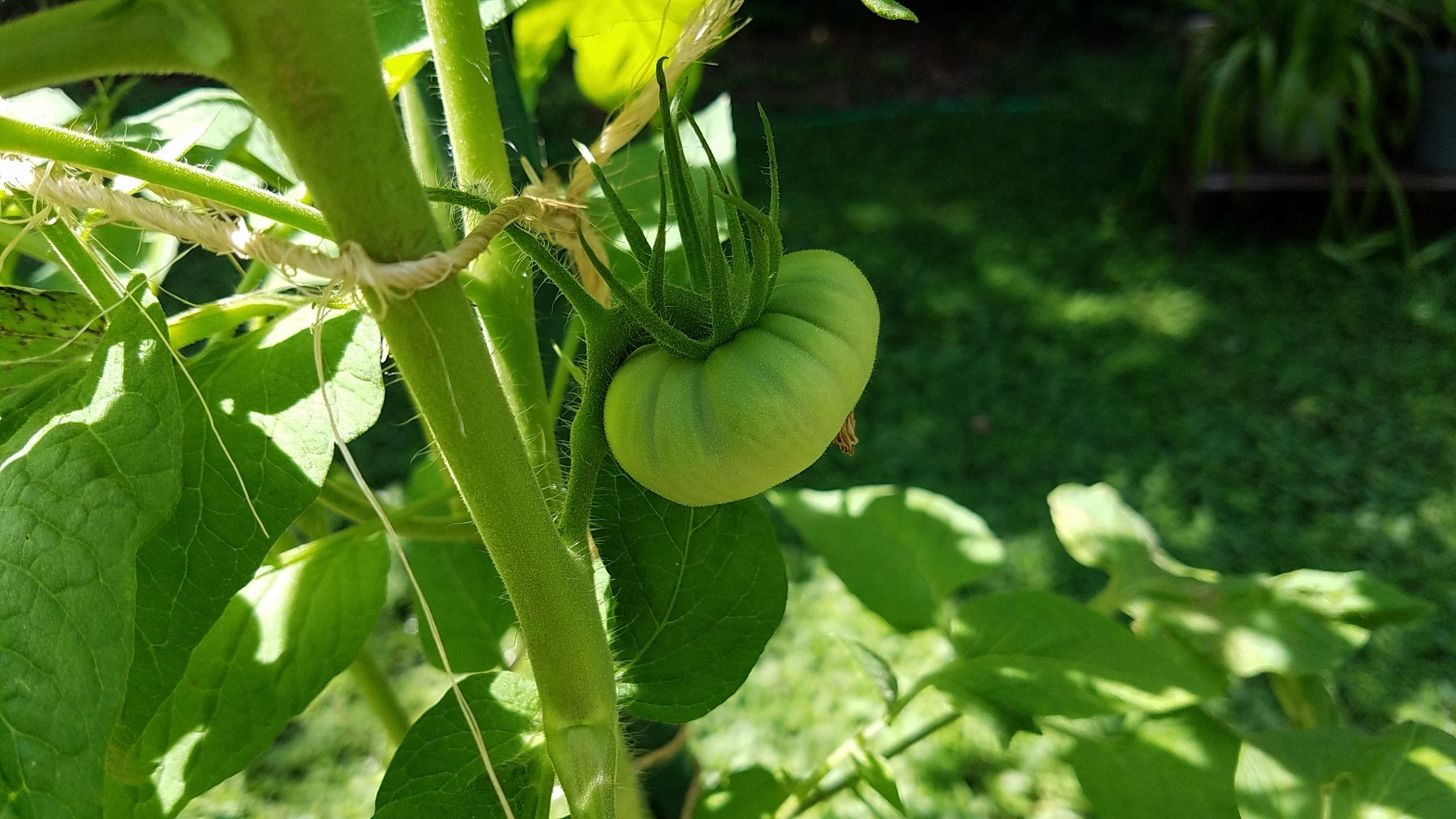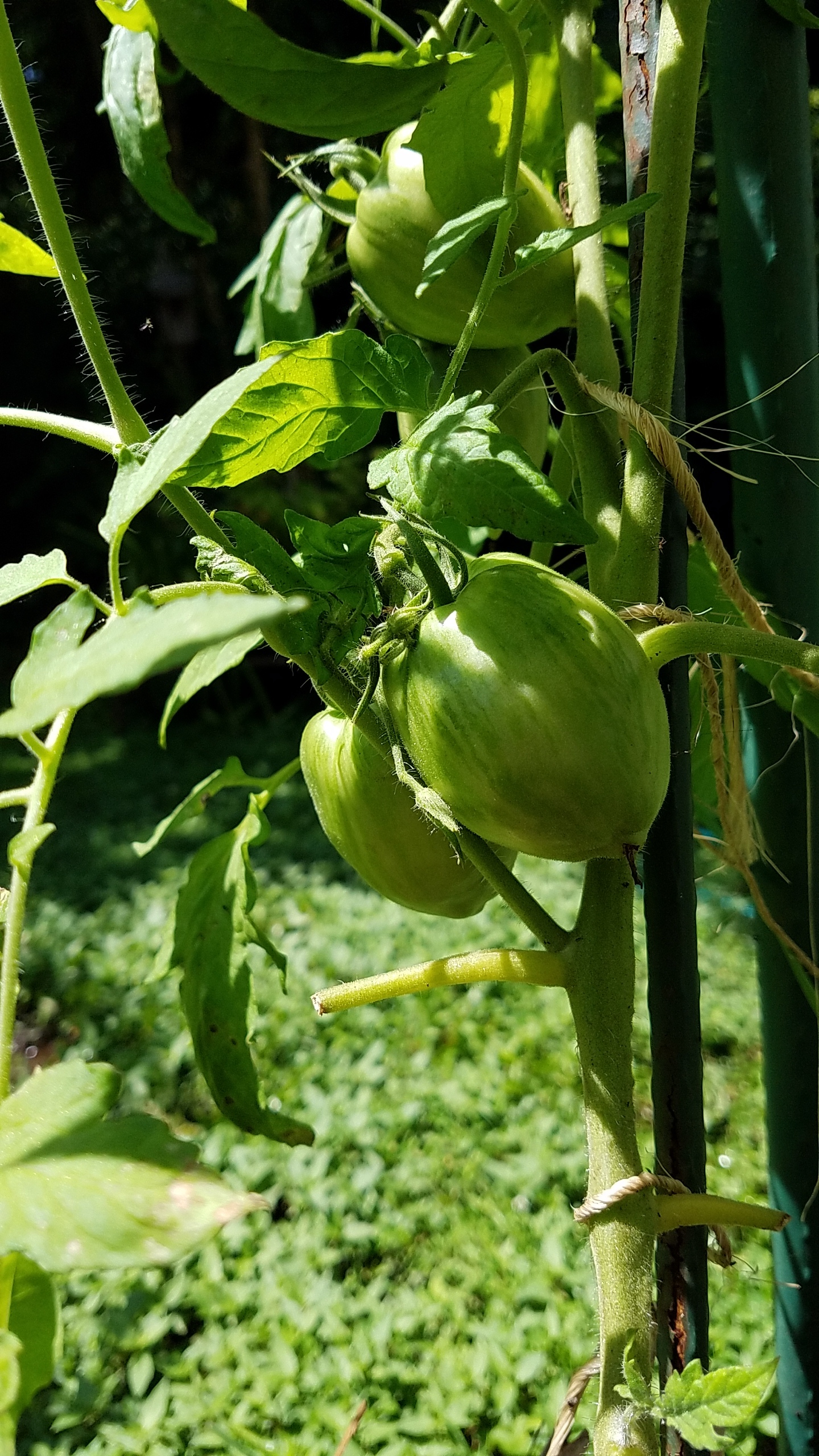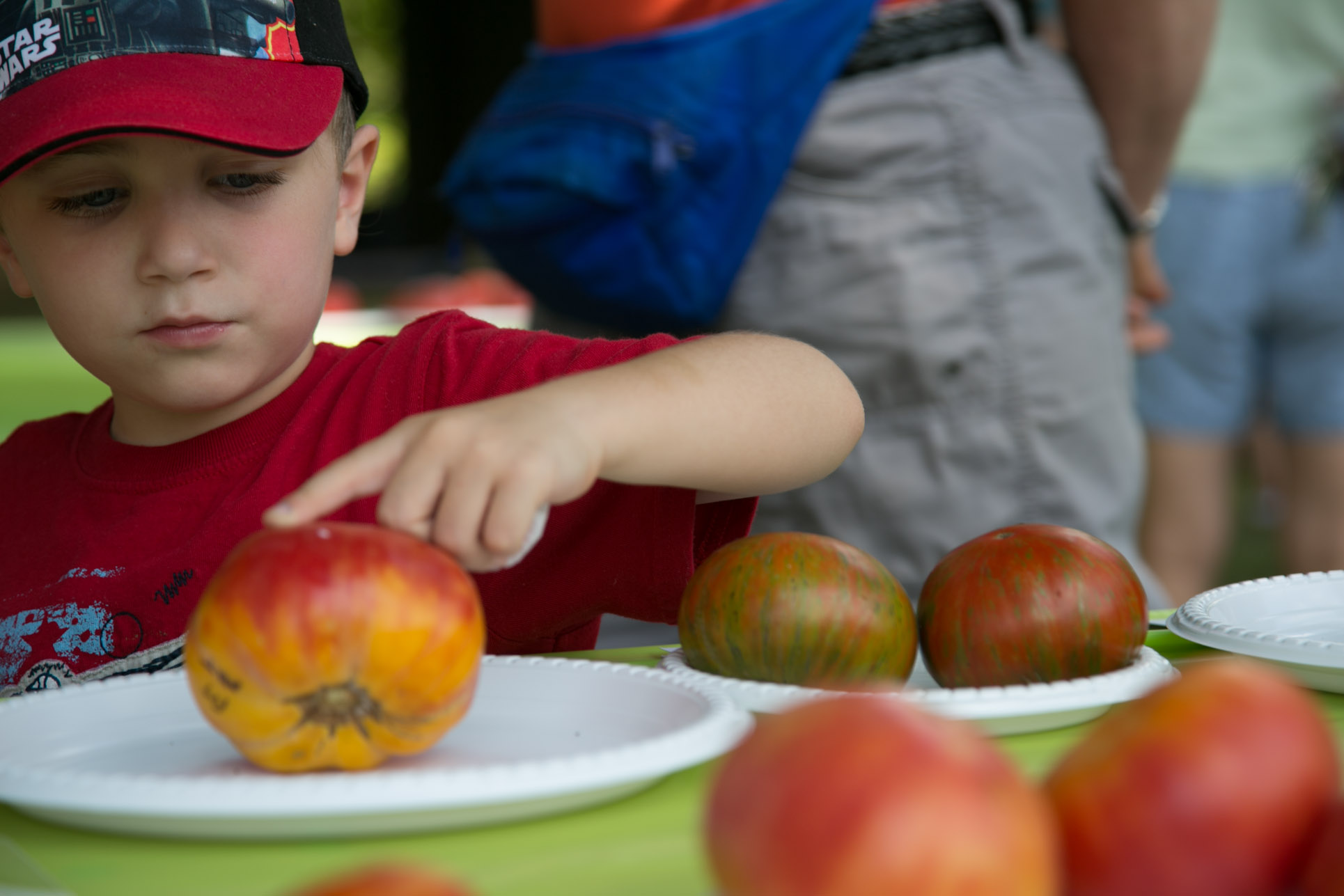Coda is a year old yellow lab/??? (border collie, perhaps?) mix, around 25-30 pounds, sweet as can be. He is not at all sure about me (his former relations with men perhaps not so good?) - but loves Sam the cat, and is happy to let Pico decide when to be friends. This feels like it will work out wonderfully, and we are so happy.
Now, on to tomatoes!
I want to talk about the indeterminate tomatoes growing in straw bales, and discuss my seed source for each variety. Non-hybrid tomato seed source is really important. With so many seed savers (which is great!), and companies offering heirlooms (also great!), AND so many varieties available to choose from (the widest variety in gardening history), accurate tomato identity is critical. Many people growing variety X or Y are actually not, due to accidental crossing, mislabeling, or misidentification. This is the basis for lots of reputedly fine varieties not working out for some gardeners - they are actually not growing what they hoped to be growing.
I am really fortunate for the timing of my tomato obsession; in the mid 1980s, just when the Seed Savers Exchange was really getting going and new heirlooms were emerging from families all over the world. Using my extensive collection of old seed catalogs and complete collection of Seed Saver Exchange yearbooks, combined with my own experience growing hundreds (thousands, more recently) of varieties, it is often easy for me to spot the mistakes.
Given my great respect for historical accuracy, I've developed a numbering system for my seed collection that lets me track the stability of so many cherished varieties.
Here is the list of my tomatoes, and a bit about their journey into my collection. For those who got seedlings for me, you may be interested in this information. For the rest of you, this may confirm your suspicions of how obsessed I really am!
The numbering I use, seen below, is as follows. T16-135, for example, means "tomato grown in 2016 - the saved seed in packet 135". A number such as "6204" means tomato number 6204, the list starting with 1 back in 1986; from the beginning of my seed saving work, I've used ever increasing numbering as varieties purchased or sent to me by others enter my collection. All of my seeds are labeled with a number of one type or another. The information is cross referenced to an Excel spreadsheet which is backed up in several places! The very first tomato in my collection is Sweet 100 hybrid, purchased from Stokes in 1986 - my list is currently at number 6393 (and I still have some to catalog in, sent by friends and dwarf project volunteers over the past few months). The very first saved tomato is T86-1, which is a volunteer paste tomato, probably Roma, that grew in my garden that year.
Here goes!
Egg Yolk - T16-135 or T17-15 (I started some of each for seedlings, then chose one to grow). T17-15 came from T16-135, which came from T14-69, which came from T13-110, which came from 3672 - which was sent to me by the Seed Savers Exchange in 2012. You can see the direct line between the introducing seed company (SSE) and the plants I sold, and what I am growing, this year.
Speckled Roman - T15-82 is from 5234 - which was purchased from Tomato Growers Supply Company in 2015. The oldest seed I have for this variety is 1144, obtained in a SSE trade in 2001 - I grew that out in 2002. The Tomato Growers tomato looks and performs identically; they've been a reliable seed source for heirlooms for decades.
OTV Brandywine - packet from Southern Exposure Seed Exchange (not numbered). Since Southern Exposure was the original company to introduce this variety, which was a collaborative breeding effort between Carolyn Male (who did the majority of the work) and I (the cross between Yellow Brandywine and ??? happened in my garden and was identified by a SSE member when seeds I sent them did not come true).
Polish - T12-21, which is from T01-45, which is from T90-08, which is from 89 - Vial 89 was sent to me by the variety discoverer, Bill Ellis of Pennsylvania, in 1988. This means that Polish growing in my garden, and in gardens of those who got plants from me, is only a few generations removed from seeds that were sent to me 30 years ago!
Nepal - T14-4 - derived from T12-23, which came from T10-5, originating with T02-39, which came from T90-7, which was saved from the seed I purchased from Johnny's Selected Seeds in 1986 - my tomato #31. Nepal is the tomato that convinced me it was time to switch from hybrids to heirlooms!
Red Brandywine - T13-135, which came from 1887 - sent to me by my friend Darrel Jones in 2007. I sent it to Darrel some time around 2006, and first got the variety via a Seed Savers trade in 1990 with someone at the Landis Valley Museum in Pennsylvania.
Sun Gold - 1076 - This is always grown from hybrid seed. I purchased it initially from Johnny's Selected Seeds in 1987 and it has been a garden fixture ever since. I've purchased it from Pine Tree and Tomato Growers Supply in addition to Johnny's....and buy it in bulk (as in 5000 seeds at a time), which works fine - tomato seeds will last for 14 years or more just stored at a typical room temperature.
Cherokee Purple - T17-6 or 7 - Though this seems imprecise, it's fine because both 17-6 and 17-7 came from plants grown from T16-104. I went back to T02-3 for the plant that gave 16-104, which came from T91-27 - and that came from 287, the vial that held the seed sent to me by J D Green unnamed in 1990. The available plants this year are therefore only a few generations removed from the variety as sent to me.
Cherokee Chocolate - T17-8 - This came from T16-120, which is from T03-132, which is from T95-47, the vial that holds the seeds from the original chocolate colored mutation found when planting Cherokee Purple T91-27. So once again, the plants this year are only a few generations removed from the variety I discovered in my garden 23 years ago.
Cherokee Green - packet from Tomato Growers Supply Company (no number). Cherokee Green originated in my garden in 1997 from some Cherokee Chocolate seed saved in 1996. I was the original supplier of the variety to Johnny's Selected Seeds and Tomato Grower's Supply, hence my trust of those sources.
Ferris Wheel - T14-24 - which came from T13-9, which was from T01-50, my first grow out of seed 1107, obtained upon request from the USDA using the GRIN portal in 1999 - it is their tomato NSL 27341; they obtained it from the Salzer Seed Company (who released it in 1894) in the 1940s. This is an example of a "commercial heirloom" - a great tomato that has been around for over 100 years but was a seed company development, not a family heirloom.
Lillian's Yellow Heirloom - T12-15 - This came from T07-9, grown from T96-60, which is from T90-14, grown from 212 - sent to me" by Robert Richardson, Seed Savers Exchange member in 1989 - and labeled at the time "Lillian's Yellow Heirloom #1". Once again, plants this year are only a few generations removed from seed sent to me 29 years ago.
Mexico Midget - T15-126 - This seed actually came from a large bag of Mexico Midget tomatoes given to me by a nearby gardening friend Chris as "windfalls" from his plant. He got his starts from me, and this tomato goes back to #251, sent to me by Barney Laman of California in 1990. I've grown it many, many times, and it is THE hardest variety to germinate.
Dester - T16-172 - this came from T15-70, which came from T12-19, my first growing of the variety from seed 3506 - this was sent to me by friends at the Seed Savers Exchange as a favor in 2012 after I got to taste it at the tomato tasting there - it blew away the competition.
Lucky Cross - T17-21 - this came from T16-87, which is from T11-50, which is from T03-39, which is from 1327, sent to me by my PA friend Larry Davis in 2003 - I shared T01-30 with him, which came from T00-24, which I initially named Lucky Cross - this came from my co-developer friend Larry's seed 1118, which came from T99-46, which came from T98-66, the initial potato leaf, large fruited bicolor from T97-21, the F1 hybrid between Brandywine and Tad, found in seed T93-58. Lucky Cross is a really fun, complicated adventure!
Brandywine - T17-25 came from T16-106, which is from T11-60, which is from T01-5, which originated with T97-27, which came from T93-58, which came from T88-9, which came from #29 - obtained from Seed Saver member Roger Wentling of PA in 1987 - Roger obtained it directly from Ben Quisenberry - so this indeed is the real thing - and the flavor is legendary!
I confess that this blog entry is as much for me as for my readers (and especially local gardeners who have some of the above plants in their gardens) - it tells each of their stories. (you should see the power point diagrams of the family trees of many of my varieties!)


